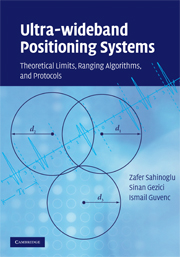Book contents
- Frontmatter
- Contents
- Preface
- 1 Introduction
- 2 Ultra-wideband signals
- 3 Ultra-wideband channel models
- 4 Position estimation techniques
- 5 Time-based ranging via UWB radios
- 6 Ranging protocols
- 7 Special topics in ranging
- 8 Practical considerations for UWB system design
- 9 Recent developments and future research directions
- References
- Index
9 - Recent developments and future research directions
Published online by Cambridge University Press: 23 December 2009
- Frontmatter
- Contents
- Preface
- 1 Introduction
- 2 Ultra-wideband signals
- 3 Ultra-wideband channel models
- 4 Position estimation techniques
- 5 Time-based ranging via UWB radios
- 6 Ranging protocols
- 7 Special topics in ranging
- 8 Practical considerations for UWB system design
- 9 Recent developments and future research directions
- References
- Index
Summary
In this chapter, some of the recent interesting research work related to UWB ranging and positioning are briefly reviewed. The purpose of the chapter is not to describe these studies in detail, but rather to point out specific recent references that may yield further research.
Development of accurate ranging/positioning algorithms
As discussed in the previous chapters, ranging and localization via UWB radios have been investigated extensively in the literature. While CRLB and ZZLB provide lower bounds on the ranging/localization accuracy, low-complexity and efficient estimators that approach these bounds in practical scenarios are still needed.
There are numerous recent research studies that aim at improving UWB ranging/localization accuracy. One research direction is joint estimation of range and location. In [170], it is shown that a two-step approach that uses independent decisions in ranging and localization steps is asymptotically optimal at high SNRs. However, it requires perfect estimates of delays, attenuations, and pulse shapes related to the received multipath components (MPCs) in order to construct an optimum correlation template at the receiver, which is very difficult to achieve in practice. Without perfect a-priori information of the channel parameters, such a two-step method returns unreliable TOA estimates during the ranging step. Since the measurements are separately performed at each reference node, without a constraint that all the measurements correspond to the location of the same mobile terminal, such approaches are suboptimal [137]. A better approach would be to make least commitment, where intermediate information is preserved and propagated till the end [393]. In other words, the received channel responses should not be discarded until a final decision regarding the target node location is made.
- Type
- Chapter
- Information
- Ultra-wideband Positioning SystemsTheoretical Limits, Ranging Algorithms, and Protocols, pp. 227 - 240Publisher: Cambridge University PressPrint publication year: 2008



